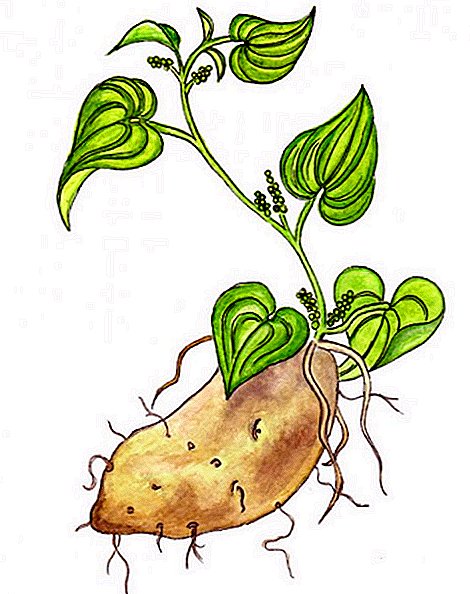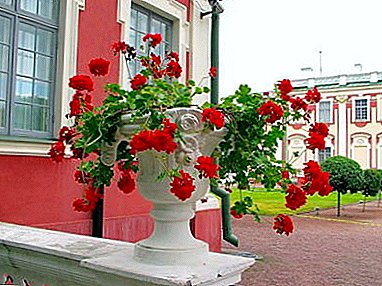 Saintpaulia or Saint-Petersburg violet is loved by many gardeners, it is beautiful, delicate and not capricious. However, over time, expanding, the flower loses its decorative effect, the soil in which it grows, exhausts, losing the nutrients the plant needs. In this article we will learn how to prevent the loss of decorative flower and will discuss step by step how to transplant violet at home.
Saintpaulia or Saint-Petersburg violet is loved by many gardeners, it is beautiful, delicate and not capricious. However, over time, expanding, the flower loses its decorative effect, the soil in which it grows, exhausts, losing the nutrients the plant needs. In this article we will learn how to prevent the loss of decorative flower and will discuss step by step how to transplant violet at home.
Time for transplant (signs)
A plant needs a transplant not only because it grows tight as it grows. Growing up, violet ugly exposes the stem below, when the ground is not able to give it the necessary nutrition.
The flower withers, its parts rot, it stops blooming. How to understand that it's time to change the capacity for violets? This is indicated by the following symptoms:
White scurf on the soil speaks of poor air throughput through it, as well as an excess of mineral substances, over time they accumulate, over-saturating the ground.
The optimal period when it is possible to replant room violets is spring. At this time, the plant is full of strength, it has enough natural light, so the adaptation in the new pot will pass without problems.  In winter, it is better not to do this, because the day is too short and you will have to provide additional lighting to the plant (for example, with a fluorescent lamp) so that it does not wither.
In winter, it is better not to do this, because the day is too short and you will have to provide additional lighting to the plant (for example, with a fluorescent lamp) so that it does not wither.
Important! In the summer, it is too hot, violet may be under stress, it will be hard for it to settle down.
Also not desirable transplant, if Saintpaulia buds or blossomed. If transplanted during budding, it will deflect flowering, and if the plant has already bloomed, it means that he does not need an urgent transplant, all the conditions are suitable.
If the plant is sick, parasites start, and a transplant is needed urgently, then it doesn’t matter what season it is, Saintpaulia needs to be saved. If this happens during flowering, then it is better to cut the buds so that the plant has enough strength to root.

Your house will be decorated with such indoor flowers as zephyranthes, orchid, geranium, chrysanthemum, hippeastrum, freesia, gardenia, cyclamen, spathiphyllum, anthurium, hibiscus.
What is needed?
To successfully complete the procedure, you need to know a few rules about how to repot violet at home:
- It is not advisable to use clay or ceramic containers for violets: the soil in them dries faster, and the lower leaves begin to rot on contact with the edges of such a pot.
- For each subsequent transplant, a larger diameter pot is needed, but without fanaticism - the plant itself must be three times more than its capacity.
- For transplanting, room water is required.
- Flowers love breathable, sour soil.
- Chernozem - five parts;
- peat - three parts;
- large river sand - one part.
The soil for Saintpaulia can be purchased at the store, but regardless of whether you bought the soil or prepared it yourself, it must be decontaminated.
It is steamed and fertilized with a solution of potassium permanganate, then a little biohumus is added. Drainage must be put on the bottom of the pot: expanded clay or fragments of pottery. 
How to prepare the plants?
Before planting violet at home, the plant itself must be prepared. So that without complications, without damaging the flower, to get it out of the pot, you need to moisten the ground a couple of hours before the procedure, trying not to soil and wet the leaves. At the same time, the soil ball should not stick to hands.
After the flower is taken out of the pot, it should be examined. If there are damages on the roots, they are cut to healthy tissue, the long overgrown roots are shortened by two thirds, and the old leaves are removed, the sections are necessarily treated with crushed coal.
In the case when the root is completely damaged and it is impossible to leave it, remove and root the bush in the water. Then, when saintpaulia shoots young growth of roots, it can be planted in the ground. 
Transfer
For transplantation, you should choose the most suitable method for your plant, but in any case, follow two rules:
- The depth at which the plant is planted - the lower leaves almost do not touch the soil surface.
- Watering on the first day is not carried out, the substrate must be wet and flowing at the same time.
Transshipment
Handling is the most suitable method for urgent transplantation, if the saintpaulia is unwell or infected with parasites, the method is also suitable for flowers that are very overgrown and have let a lot of children.
A new pot is filled to a third of the height with drainage material, sprinkling a small amount of soil on top. The flower is carefully thrown out of the old pot, fully preserving the soil ball.
An old pot is inserted into a new one and the ground between their walls is filled with soil. Tap the walls of the pot to seal the soil. After that, the old tank is removed, and violet is planted in its place, so that the levels of the new and old soil are on the same line.
Full replacement
A complete replacement is needed for an exhausted, soured soil, it is not capable of giving the flower enough air, in it the root system begins to rot from the excess accumulated mineral elements.
At the same time, the roots are cleaned from old processes and rotted parts, shortened, old, yellowed or sluggish leaves are removed.
Important! After processing the roots, all slices must be powdered with crushed coal, otherwise the infection will develop and the flower will die.
At the bottom of the tank put a drain, then a pile of fresh soil mixture. On a hill of soil, straightening loosely the roots, lay a violet and cover it with soil to the line of the lower leaves.
In order for the potted soil to be tamped, the soil is tapped on the walls of the container and, if necessary, sprinkled on the soil, the leg of the plant should not be bare.
Partial replacement
Most often, for a planned transplant of violets at home, especially miniature ones, a partial renewal of the soil is sufficient. Such a method makes it possible to plant an expanded plant without damaging the root processes.
In this case, when the shrub is taken out of the pot, the former soil clod on the roots is left, shaking only what is showered. 
Did you know? A delicate flower, or rather an unknown species of African violet, was discovered by Baron Walter Saint Paul Iller, who discovered it in the gorge of the Uzambarsky mountains in 1892. It was this species that became the main one for breeding indoor hybrids.
Growing conditions
In order for your violet not to hurt and not sickly, she needs to ensure proper conditions:
- The lighting is bright, but not in direct sunlight, in the winter, you need to light the fitolamp.
- The soil should always be wet.
- Water for irrigation - room temperature, separated.
- The best way to water is to moisten through a drip pan; be sure to drain the rest of the water.
- When watering can not leave moisture on the leaves, you can not spray them.
- In the summer, watering is carried out in small doses, daily, in the winter - twice a week.
- Leaves of dust can be cleaned under the shower, but the flower is taken out of the bathroom dry.
- There should be no heaters or fans near the senpolia.
- You can not leave it in a draft.
- Temperature range - from 18 to 25 ° C.
- Humidity is moderate, 50%.
- Faded flowers must be removed.
Proper care will provide a healthy and flowering look to the plant, and violet blooms for about two months. 
Did you know? The medieval Germanic tribes had a tradition to celebrate the spring day, when the first violet was found. The ancient Greeks and Romans decorated their houses, altars and statues of gods with these flowers, weaving wreaths and garlands for the holidays.
Esoteric and experts on feng shui argue that the violet in the house creates an atmosphere of peace, comfort, smoothes out conflicts and makes people more tolerant and more sympathetic to each other. Take care of your plants properly and with love, and they will delight you with lush and delicate color.












